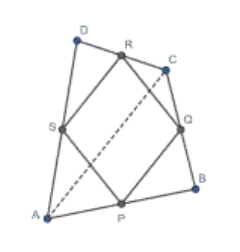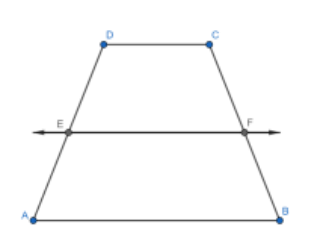Score Higher With Vedantu's Class 9 Quadrilaterals Exercise 8.2 Solutions
NCERT Solutions for Class 9 Maths Chapter 8 Quadrilaterals
FAQs on NCERT Solutions for Class 9 Maths Chapter 8 Quadrilaterals
1. What are the step-by-step methods to solve questions in NCERT Solutions for Class 9 Maths Chapter 8 Exercise 8.2?
To solve questions in Exercise 8.2 of Class 9 Maths Chapter 8 (Quadrilaterals) as per CBSE 2025–26, follow these methods:
- Identify the type of quadrilateral and properties required (e.g., parallelogram, rhombus, rectangle).
- State the known information and what needs to be proved.
- Apply relevant theorems like the Midpoint Theorem or properties of parallelograls.
- Draw auxiliary lines (such as diagonals) if needed for construction.
- Write each step of the proof logically, referencing theorems or geometric rules.
- Clearly justify each statement with reasons based on textbook concepts.
2. How does the Midpoint Theorem help in solving Class 9 Chapter 8 Exercise 8.2 problems?
The Midpoint Theorem states that a line segment joining the midpoints of two sides of a triangle is parallel to the third side and half its length. In Exercise 8.2, this theorem helps to:
- Prove parallelism between constructed line segments and diagonals.
- Demonstrate length relationships, such as a segment being half of a diagonal.
- Establish properties for specific figures like parallelograms, rectangles, and rhombuses, supporting step-by-step proofs.
3. What are the main properties of parallelograms applied in NCERT Solutions for Class 9 Maths Chapter 8?
Key properties of parallelograms used in Chapter 8 solutions are:
- Opposite sides are equal and parallel.
- Opposite angles are equal.
- Diagonals bisect each other.
- The sum of any two adjacent angles is 180°.
4. How can you prove that a quadrilateral is a parallelogram in Class 9 Exercise 8.2?
To prove a quadrilateral is a parallelogram as per CBSE 2025–26:
- Show both pairs of opposite sides are equal or parallel.
- Alternatively, prove that one pair of opposite sides is both equal and parallel.
- Or demonstrate that diagonals bisect each other.
5. Why is it necessary to write stepwise solutions in Class 9 Maths NCERT exercises?
Stepwise solutions reflect the CBSE marking scheme, helping students:
- Demonstrate understanding of the solving process.
- Justify each conclusion with proper geometric reasoning.
- Earn full marks even if a minor calculation error occurs, provided correct methods are shown.
6. What alternative approaches can be used if standard theorems do not apply directly in Exercise 8.2?
If standard theorems do not apply directly, students can:
- Use auxiliary constructions, such as extending lines or drawing diagonals.
- Transpose the problem to triangles via construction, then apply triangle theorems.
- Leverage known angle relationships or properties of supplementary angles.
7. What errors should students avoid while writing NCERT Solutions for Class 9 Chapter 8 Quadrilaterals?
Common mistakes to avoid include:
- Missing steps in logical reasoning or skipping justifications.
- Confusing properties of similar-looking quadrilaterals (e.g., rectangle vs. rhombus).
- Incorrectly applying the Midpoint Theorem to non-triangular figures.
- Not labeling diagrams or figures clearly as per question requirements.
8. How can the NCERT Class 9 Solutions for Exercise 8.2 improve problem-solving skills for geometry?
NCERT Solutions for Exercise 8.2 improve problem-solving by:
- Developing systematic reasoning through structured proofs.
- Building familiarity with applying key geometric theorems.
- Enhancing skills in diagram interpretation and logical deduction.
9. In Class 9 Chapter 8, how is the concept of diagonals bisecting each other utilized in proofs?
The property that diagonals bisect each other is crucial to:
- Prove a quadrilateral is a parallelogram.
- Support congruence arguments by showing matching triangle sides or angles.
- Divide figures into smaller congruent segments to facilitate further proofs.
10. What is a common misconception about parallelograms in Class 9 Quadrilaterals?
A common misconception is assuming that any quadrilateral with equal diagonals or equal sides is a parallelogram. However, the precise criteria (as per CBSE) are:
- Both pairs of opposite sides must be equal and parallel,
- or diagonals bisect each other.
11. Why is the application of theorems emphasized in NCERT Solutions for Class 9 Quadrilaterals?
Applying theorems (like Midpoint Theorem, Angle Sum Property, Parallelogram Properties):
- Shows a deeper understanding of geometry rather than rote learning.
- Is required by the CBSE marking guidelines for full credit.
- Prepares students for advanced geometry and competitive exams by enhancing proof-writing skills.
12. How can students check if their NCERT Solutions for Class 9 Maths Chapter 8 match the CBSE exam requirements?
Students should ensure their solutions:
- Are written stepwise with proper justification.
- Use correct geometric terminology and statements.
- Include clear diagrams where required.
- Reference the application of theorems as per CBSE 2025–26 syllabus.
13. How do NCERT Solutions for Class 9 Quadrilaterals Exercise 8.2 address HOTS and application-based questions?
NCERT Solutions for this exercise integrate HOTS and application by:
- Providing structured proofs for complex figures.
- Requiring use of theorems in unfamiliar configurations.
- Encouraging multi-step reasoning and connecting properties across quadrilaterals and triangles.
14. What is the significance of proving statements in geometry rather than only stating the answer, as practiced in NCERT Solutions?
Proving statements rather than just stating the answer:
- Demonstrates understanding and application of mathematical logic.
- Aligns with CBSE’s emphasis on reasoning-based marking schemes.
- Prepares students for higher classes where proof-writing is essential.
15. Can you list frequent CBSE exam traps or difficult areas in Class 9 Chapter 8 Exercise 8.2 solutions?
Common exam traps in Exercise 8.2 include:
- Misidentifying the type of quadrilateral when given only side or angle properties.
- Missing the correct application of the Midpoint Theorem (especially in non-standard figures).
- Ignoring the need for construction in complex proofs.
- Overlooking required stepwise reasoning and justification expected by CBSE.














 Watch Video
Watch Video




















